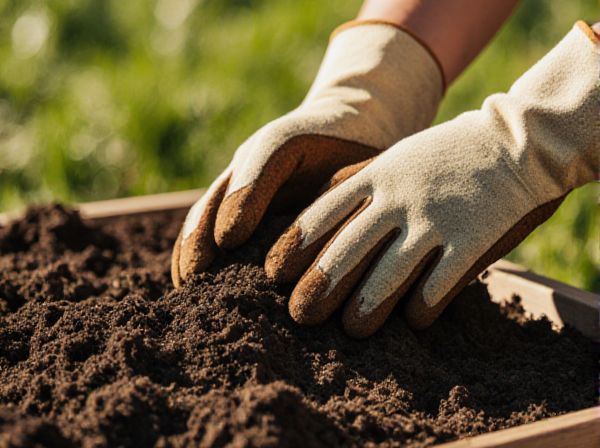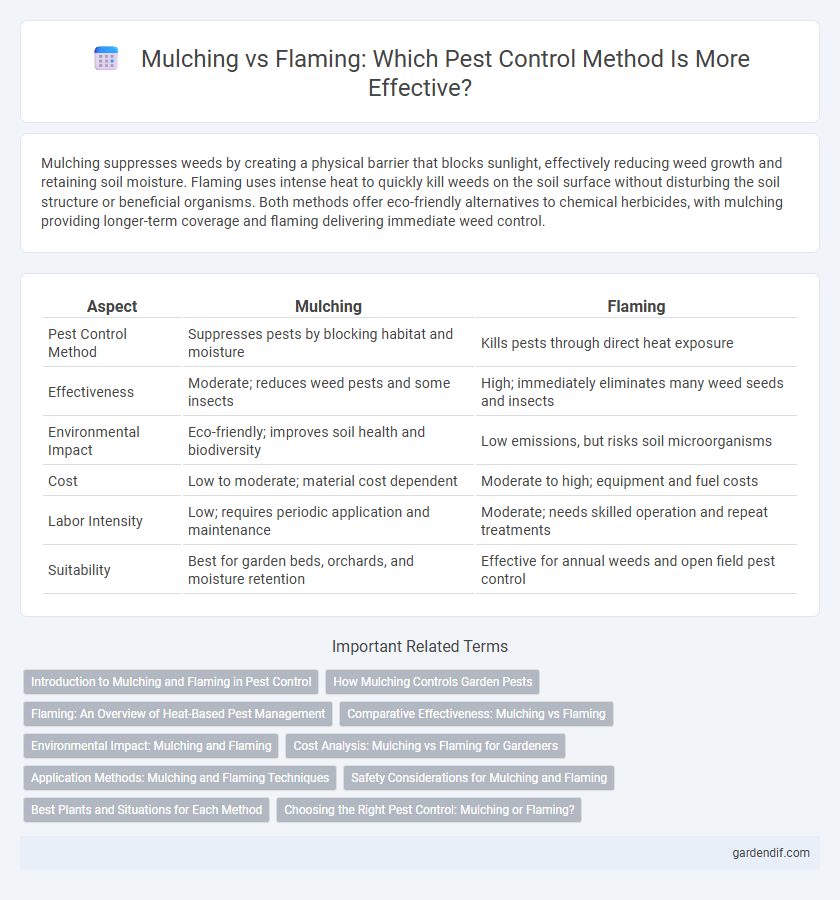
mulching vs flaming Illustration
Mulching suppresses weeds by creating a physical barrier that blocks sunlight, effectively reducing weed growth and retaining soil moisture. Flaming uses intense heat to quickly kill weeds on the soil surface without disturbing the soil structure or beneficial organisms. Both methods offer eco-friendly alternatives to chemical herbicides, with mulching providing longer-term coverage and flaming delivering immediate weed control.
Table of Comparison
| Aspect | Mulching | Flaming |
|---|---|---|
| Pest Control Method | Suppresses pests by blocking habitat and moisture | Kills pests through direct heat exposure |
| Effectiveness | Moderate; reduces weed pests and some insects | High; immediately eliminates many weed seeds and insects |
| Environmental Impact | Eco-friendly; improves soil health and biodiversity | Low emissions, but risks soil microorganisms |
| Cost | Low to moderate; material cost dependent | Moderate to high; equipment and fuel costs |
| Labor Intensity | Low; requires periodic application and maintenance | Moderate; needs skilled operation and repeat treatments |
| Suitability | Best for garden beds, orchards, and moisture retention | Effective for annual weeds and open field pest control |
Introduction to Mulching and Flaming in Pest Control
Mulching involves applying organic or inorganic materials to soil surfaces, creating a physical barrier that suppresses weed growth and deters pests, while enhancing soil moisture retention and microbial activity. Flaming uses controlled bursts of flame to target and eliminate pest insects and weed seeds without harmful chemicals, effectively disrupting pest life cycles. Both methods offer eco-friendly alternatives to conventional pesticides, promoting sustainable pest management in agricultural and garden settings.
How Mulching Controls Garden Pests
Mulching controls garden pests by creating a physical barrier that suppresses weed growth and reduces habitat for insects like slugs and beetles, which thrive in exposed soil. Organic mulches, such as wood chips or straw, promote beneficial soil organisms that naturally prey on harmful pests, enhancing garden health. Mulch also maintains soil moisture and temperature, creating less favorable conditions for certain pests to proliferate.
Flaming: An Overview of Heat-Based Pest Management
Flaming is a heat-based pest management technique that uses controlled fire to eliminate weeds and soil-borne pests without chemicals. This method rapidly raises the temperature of plant tissues, causing cell rupture and death in targeted pests while preserving soil health. Effective for organic farming, flaming reduces reliance on herbicides and promotes sustainable weed control.
Comparative Effectiveness: Mulching vs Flaming
Mulching suppresses pests by creating a physical barrier and enhancing soil health, leading to long-term pest resistance. Flaming provides immediate pest control by directly exposing pests to heat, effectively reducing weed populations without chemical use. Comparing effectiveness, mulching offers sustained protection with improved soil moisture retention, while flaming delivers rapid pest eradication but may require repeated applications for lasting results.
Environmental Impact: Mulching and Flaming
Mulching reduces soil erosion and enhances moisture retention, promoting biodiversity by providing habitat for beneficial organisms. Flaming eliminates pests without chemicals, lowering toxic residue and preventing soil contamination, but may release greenhouse gases through combustion. Both methods offer eco-friendly pest control options, with mulching supporting long-term soil health and flaming providing targeted pest reduction.
Cost Analysis: Mulching vs Flaming for Gardeners
Mulching offers a cost-effective solution for pest control by conserving soil moisture and suppressing weeds, reducing the need for chemical treatments and frequent watering. Flaming, while providing immediate and targeted weed elimination, involves higher upfront costs due to fuel consumption and specialized equipment maintenance. Gardeners must weigh the long-term savings of mulching against the precision and speed of flaming when evaluating pest management expenses.
Application Methods: Mulching and Flaming Techniques
Mulching involves applying organic or synthetic layers on soil surfaces to suppress weeds by blocking sunlight and retaining moisture, commonly using straw, wood chips, or plastic films. Flaming utilizes controlled propane-fueled flames directed at weeds to rapidly denature plant cells and inhibit regrowth without disturbing the soil structure. Both techniques require precise application timing and equipment calibration to maximize weed control efficacy while minimizing crop damage and environmental impact.
Safety Considerations for Mulching and Flaming
Mulching reduces weed growth by smothering seeds and provides a protective barrier that minimizes soil erosion without risking fire hazards. Flaming uses intense heat to kill pests and weeds, but it requires strict adherence to safety protocols to prevent accidental fires and protect nearby plants. Proper equipment, weather conditions, and operator training are essential to ensure safe and effective flaming.
Best Plants and Situations for Each Method
Mulching is ideal for moisture-loving plants such as tomatoes, peppers, and leafy greens, as it helps retain soil moisture and suppresses weeds effectively in garden beds or densely planted areas. Flaming suits hardy, fire-resistant plants like grapevines, berry bushes, and ornamental grasses, especially in large-scale or commercial settings where rapid weed control between rows is essential without disturbing root systems. Choosing mulching or flaming depends on plant sensitivity, soil conditions, and the level of weed pressure to maximize growth and minimize pest habitats.
Choosing the Right Pest Control: Mulching or Flaming?
Mulching provides a natural barrier that suppresses weed growth and retains soil moisture, creating a habitat less favorable for pests such as aphids and whiteflies. Flaming, a thermal weed control method, effectively destroys weed seeds and larvae by applying intense heat, reducing pest populations without chemical use. Selecting between mulching and flaming depends on the pest species targeted, soil health, and environmental impact considerations for sustainable pest management.
mulching vs flaming Infographic

 gardendif.com
gardendif.com